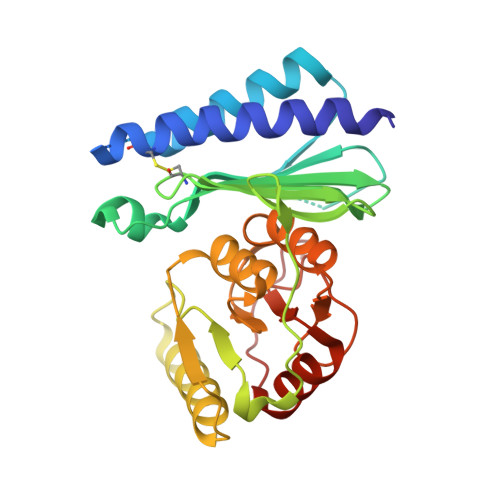Structural and biochemical analysis of human inositol monophosphatase-1 inhibition by ebselen.
Abuhammad, A., Laurieri, N., Rice, A., Lowe, E.D., Singh, N., Naser, S.M., Ratrout, S.S., Churchill, G.C.(2023) J Biomol Struct Dyn : 1-13
- PubMed: 36762717
- DOI: https://doi.org/10.1080/07391102.2023.2176925
- Primary Citation of Related Structures:
7VCE - PubMed Abstract:
Bipolar disorder is a major psychiatric disorder associated with cognitive impairment and a high suicide rate. Frontline therapy for this condition includes lithium (Li + )-containing treatments that can exert severe side effects. One target of Li + is inositol monophosphatase-1 (IMPase1); inhibition of IMPase1 through small-molecule compounds may provide an alternative treatment for bipolar disorder. One such compound is the anti-inflammatory drug ebselen, which is well tolerated and safe; however, ebselen's exact mechanism of action in IMPase1 inhibition is not fully understood, preventing rational design of IMPase1 inhibitors. To fill this gap, we performed crystallographic and biochemical studies to investigate how ebselen inhibits IMPase1. We obtained a structure of IMPase1 in space group P 2 1 after treatment with ebselen that revealed three key active-site loops (residues 33-44, 70-79, and 161-165) that are either disordered or in multiple conformations, supporting a hypothesis whereby dynamic conformational changes may be important for catalysis and ebselen inhibition. Using the thermal shift assay, we confirmed that ebselen significantly destabilizes the enzyme. Molecular docking suggests that ebselen could bind in the vicinity of His217. Investigation of the role of IMPase1 residues His217 and Cys218 suggests that inhibition of IMPase1 by ebselen may not be mediated via covalent modification of the active-site cysteine (Cys218) and is not affected by the covalent modification of other cysteine residues in the structure. Our results suggest that effects previously ascribed to ebselen-dependent inhibition likely result from disruption of essential active-site architecture, preventing activation of the IMPase1-Mg 2+ complex.Communicated by Ramaswamy H. Sarma.
Organizational Affiliation:
Department of Pharmaceutical Sciences, School of Pharmacy, The University of Jordan, Amman, Jordan.














